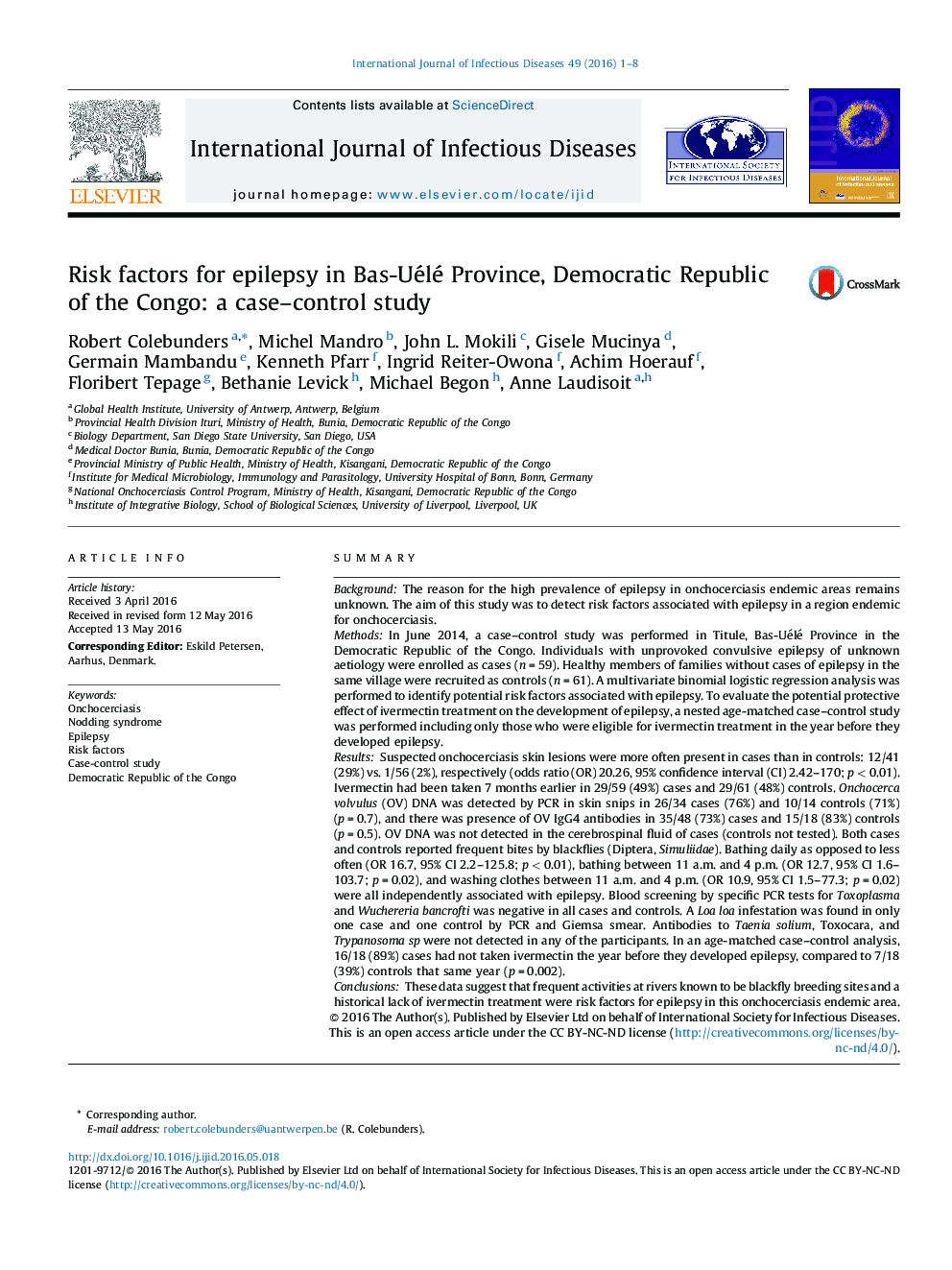| کد مقاله | کد نشریه | سال انتشار | مقاله انگلیسی | نسخه تمام متن |
|---|---|---|---|---|
| 3361610 | 1592045 | 2016 | 8 صفحه PDF | دانلود رایگان |

• In Titule, onchocerciasis suspected skin lesions were associated with epilepsy.
• Frequent activities at rapid flowing rivers were associated with epilepsy.
• A historical lack of Ivermectin treatment was a risk factors for epilepsy.
SummaryBackgroundThe reason for the high prevalence of epilepsy in onchocerciasis endemic areas remains unknown. The aim of this study was to detect risk factors associated with epilepsy in a region endemic for onchocerciasis.MethodsIn June 2014, a case–control study was performed in Titule, Bas-Uélé Province in the Democratic Republic of the Congo. Individuals with unprovoked convulsive epilepsy of unknown aetiology were enrolled as cases (n = 59). Healthy members of families without cases of epilepsy in the same village were recruited as controls (n = 61). A multivariate binomial logistic regression analysis was performed to identify potential risk factors associated with epilepsy. To evaluate the potential protective effect of ivermectin treatment on the development of epilepsy, a nested age-matched case–control study was performed including only those who were eligible for ivermectin treatment in the year before they developed epilepsy.ResultsSuspected onchocerciasis skin lesions were more often present in cases than in controls: 12/41 (29%) vs. 1/56 (2%), respectively (odds ratio (OR) 20.26, 95% confidence interval (CI) 2.42–170; p < 0.01). Ivermectin had been taken 7 months earlier in 29/59 (49%) cases and 29/61 (48%) controls. Onchocerca volvulus (OV) DNA was detected by PCR in skin snips in 26/34 cases (76%) and 10/14 controls (71%) (p = 0.7), and there was presence of OV IgG4 antibodies in 35/48 (73%) cases and 15/18 (83%) controls (p = 0.5). OV DNA was not detected in the cerebrospinal fluid of cases (controls not tested). Both cases and controls reported frequent bites by blackflies (Diptera, Simuliidae). Bathing daily as opposed to less often (OR 16.7, 95% CI 2.2–125.8; p < 0.01), bathing between 11 a.m. and 4 p.m. (OR 12.7, 95% CI 1.6–103.7; p = 0.02), and washing clothes between 11 a.m. and 4 p.m. (OR 10.9, 95% CI 1.5–77.3; p = 0.02) were all independently associated with epilepsy. Blood screening by specific PCR tests for Toxoplasma and Wuchereria bancrofti was negative in all cases and controls. A Loa loa infestation was found in only one case and one control by PCR and Giemsa smear. Antibodies to Taenia solium, Toxocara, and Trypanosoma sp were not detected in any of the participants. In an age-matched case–control analysis, 16/18 (89%) cases had not taken ivermectin the year before they developed epilepsy, compared to 7/18 (39%) controls that same year (p = 0.002).ConclusionsThese data suggest that frequent activities at rivers known to be blackfly breeding sites and a historical lack of ivermectin treatment were risk factors for epilepsy in this onchocerciasis endemic area.
Journal: International Journal of Infectious Diseases - Volume 49, August 2016, Pages 1–8